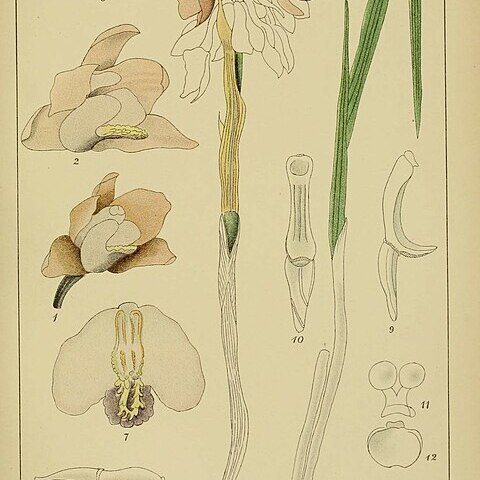Terrestrial, semi-robust herb, with subterranean, moniliformous rhizomes, 0.2-0.5 m high. Leaves plicate, 250 x 16 mm, emerging during anthesis. Inflorescence elongate, dense, 5-30-flowered. Flowers with sepals dull brownish green outside, orange-brown inside, petals yellow, veins marked brownish red inside, lip midlobe bright yellow, side lobes tinged purple. Sepals: median sepal 10-14 mm long, narrowly obovate, obtuse or mucronate; lateral sepals similar. Petals a little shorter than median sepal. Lip 3-lobed, crests with low, broad verrucose ridges on central veins, side lobes adnate to mentum; mentum shorter than gynostemium; spur conical, 2-5 mm long. Gynostemium 4-8 mm long. Flowering time Oct.-Jan.
Herb, up to 500 mm high. Leaves partly extended at anthesis, up to 250 x 16 mm. Flowers: petals often shortly clawed, obovate-elliptic; gynostemium 4-8 mm long; side lobes of lip obliquely truncate; median sepal 7-30 mm long; spur 2-5 mm long; sepals dull brownish green outside, rich orange-brown inside, petals pale yellow, lip yellow; Aug.-Oct.
Rhizomatous geophyte to 50 cm. Leaves emergent at flowering, leathery. Flowers few to many in a dense, elongate raceme, sepals brownish green, petals and lip yellow, lip side lobes tinged purple, median sepal 10-14 mm long, lip crests of low, warty ridges, spur conic to subcylindrical, 2-5 mm long.
Terrestrial herb, up to 500 mm tall. Petals often shortly clawed, obovate-elliptic. Column 4- long. Side lobes of lip obliquely truncate. Flowers with sepals dull brownish green outside, rich orange-brown inside, petals pale yellow, lip yellow.
Lip 18 mm long with several low ridges down the centre, 3-lobed; side lobes quadrate; mid-lobe 4 mm wide, truncate or emarginate; spur 3–5 mm long, conical or cylindrical, blunt.
Sepals brown or greenish, heavily veined with purple; petals yellow on the back, veined with light to dark red inside; lip yellow, with purple veins on side lobes.
Leaves c. 5 in a tuft, later up to 25 × 1.6 cm, rather coriaceous, just appearing at flowering time.
Flowering stem 20–50 cm tall, several-flowered, the scape with about 4 loose bracts to 7.5 cm long.
Sepals obovate-oblong, apiculate; dorsal sepal c. 16 × 4 mm; lateral sepals 14–15 × 4–5.5 mm.
Perennating organs subterranean, tuber-like, forming a chain.
Petals 12 × 6–8 mm, obovate, rounded at apex.
Pedicel and ovary 15–16 mm long.
Bracts 12–13 mm long.
Column 4–8 mm long.
Terrestrial herb.

